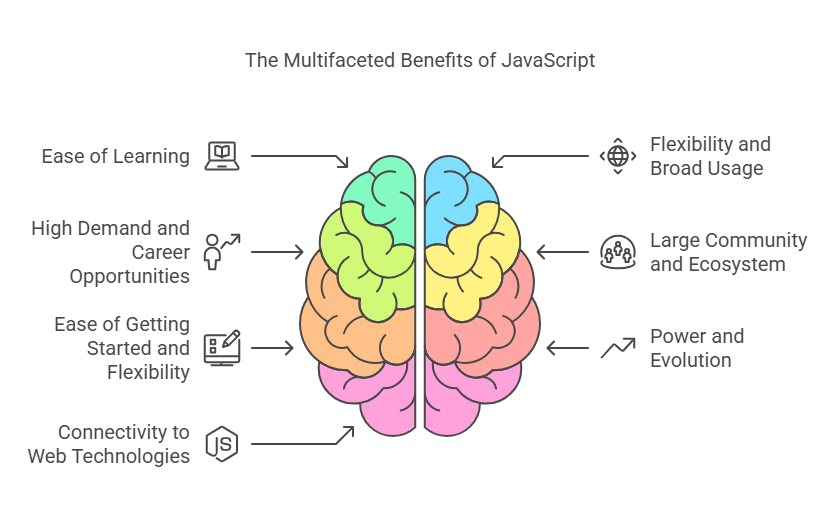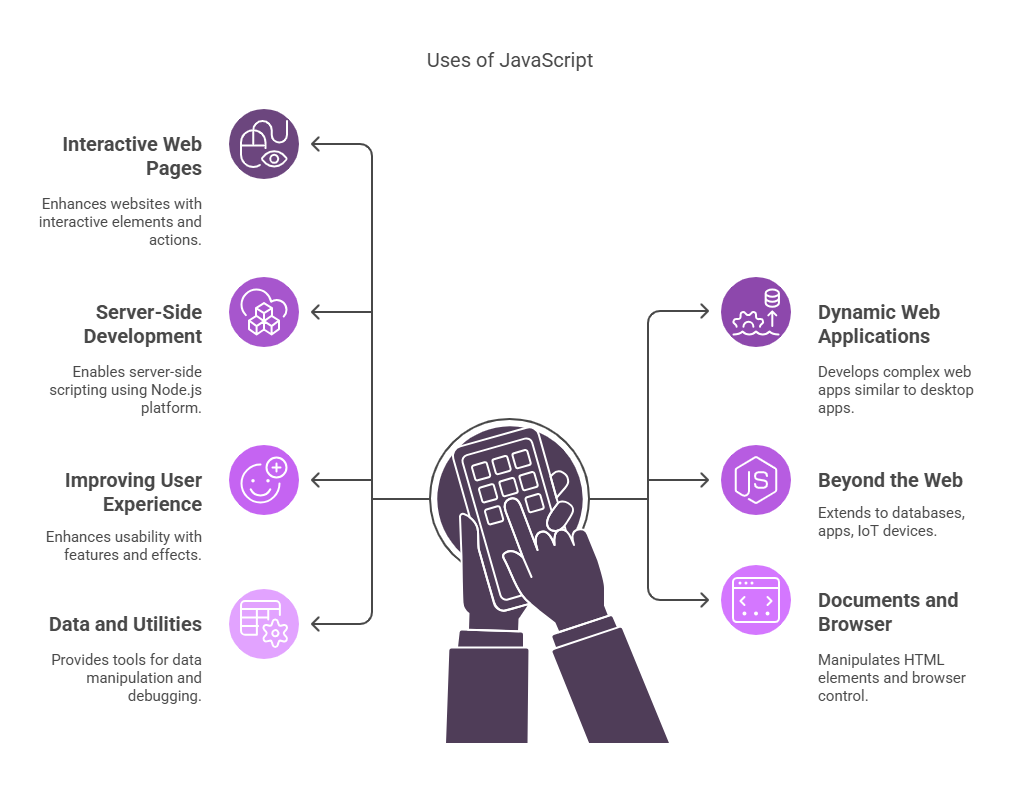Advantages and Uses Of JavaScript
Many people agree that JavaScript is an essential and very useful programming language in today’s technological environment. It is so common, especially on the web, that it is frequently regarded as the most popular programming language. Gaining knowledge of JavaScript is essential to mastering web programming and opens you a world of opportunities.
Advantages of JavaScript
Learning JavaScript is highly recommended for the following reasons:

Easy to Learn and Easily Reachable: A fantastic programming language for novices is JavaScript. To begin, no prior knowledge of JavaScript is required. Basic knowledge of HTML and CSS is not necessary, however, it can be helpful. You can start creating interesting applications really fast, and learning the fundamentals is simple. The first thing you need is a computer with a text editor and a browser, which you already have. Basic JavaScript programming is easy to comprehend.
Flexibility and Broad Usage: Web development and many other applications make considerable use of JavaScript, an incredible multifunctional language. Because it is native to web browsers, it is highly integrated and web-optimized. It works on servers and browsers. Desktop apps, web servers, cellphones, and tablets employ JavaScript.
High Demand and Career Opportunities: Because JavaScript is a “hot” language, there is a greater need than ever for JavaScript programmers. It is among the most sought-after abilities in the labour market. Gaining proficiency in JavaScript may be essential to understanding fundamental programming ideas and securing a well-paying position. JavaScript programmers are expected to see a sharp rise in employment.
Large Community and Ecosystem: The JavaScript community is incredibly active and well-liked. Issue answers are readily available online for beginners. Many frameworks and libraries, such as React, Vue.js, jQuery, Angular, and Node.js, can simplify and speed up development. With frameworks frequently offering a standard structure for apps, these libraries are pre-written code that you may utilise. Older codebases continue to use jQuery, which has historically been crucial for standardising browser behaviour.
Ease of Getting Started and Flexibility: Enter code into the browser’s developer tools console to play JavaScript. Expression and flexibility make it suitable for functional and object-oriented programming. JavaScript code doesn’t require compilation because it’s just text, therefore you can use any basic text editor.
Power and Evolution: Although JavaScript was once thought to be a slow and peculiar language, it has since improved and grown considerably more powerful. Code continues to improve and now runs much faster than it did in the past. It has strong underpinnings and is expressive, adaptable, and strong. Since JavaScript is a living language, new features are added on a regular basis.
Connectivity to Web Technologies: Along with HTML and CSS, JavaScript is one of the three prerequisite languages for web developers. Content is defined by HTML, layout by CSS, and behaviour is programmed by JavaScript. You can work with HTML components and CSS styles with JavaScript’s complete integration with HTML and CSS.
Common uses of JavaScript
A vast array of features are made possible by JavaScript’s extraordinary versatility:

Creating Interactive Web Pages (Client-Side): Arguably, this is the most typical use case. JavaScript makes web sites more interactive. JavaScript is frequently used in web page interactions, such as button clicks and other actions that require more than a static page. Information may be sent or received more easily, improving the user experience. This covers features like pop-up windows, rollover-effect interactive buttons, and making sure forms have the right data entered.
Building Dynamic Web Applications: JavaScript has advanced to the point where it can now develop complex web apps that function similarly to native desktop apps. Dynamic web pages are capable of a wide range of functions. Websites and online applications that are interactive can be made with HTML, CSS, and JavaScript.
Server-Side Development (Node.js): JavaScript is not just for browsers; it can also be used on the server side with Node.js. You can write command-line software, build HTTP servers, build backend logic for applications, and work with databases using Node.js. It permits network communication and file reading and writing by giving access to the full operating system. JavaScript is made into a general-purpose programming language by Node.js.
Beyond the Web: JavaScript is not just for web browsers and servers. Databases (such as MongoDB and CouchDB), smartphone apps, wearable technology, desktop widgets, PDF documents, desktop programming platforms, and the Internet of Things all make use of it.
Improving User Experience: Many features and effects that enhance the usability of websites are made possible via JavaScript:
- Input verification.
- Rollover consequences.
- Menus that drop down or fly out.
- Drag and drop functionality.
- Page scrolling indefinitely and autocomplete.
- Lists that can be sorted and progress meters.
- Visual effects and animations.
- Submitting Ajax requests to dynamically load new data.
Working with Documents and the Browser: Customer-side Web page content scripting is the main function of JavaScript. Through its connection to the Document Object Model (DOM), an HTML page is transformed into a logical tree that enables you to work with and modify elements, styles, attributes, and events. Using items like the Window object, it also enables control over the browser itself.
Working with Data and Utilities: JavaScript offers a standard library that contains useful tools. Working with data structures like sets, maps, and typed arrays, managing dates and URLs, matching patterns with regular expressions, and serialising data using JSON are all included in this. Additionally, it offers ways to debug by publishing to the browser console (console.log()) and to obtain user input (prompt()).
Finally, learning JavaScript gives you access to a programming language that is powerful, flexible, and extensively utilised. It has a vibrant community and a wide range of job options. It is a fundamental talent for contemporary programming because of its capabilities on both the client and server sides as well as its expansion into other fields.
